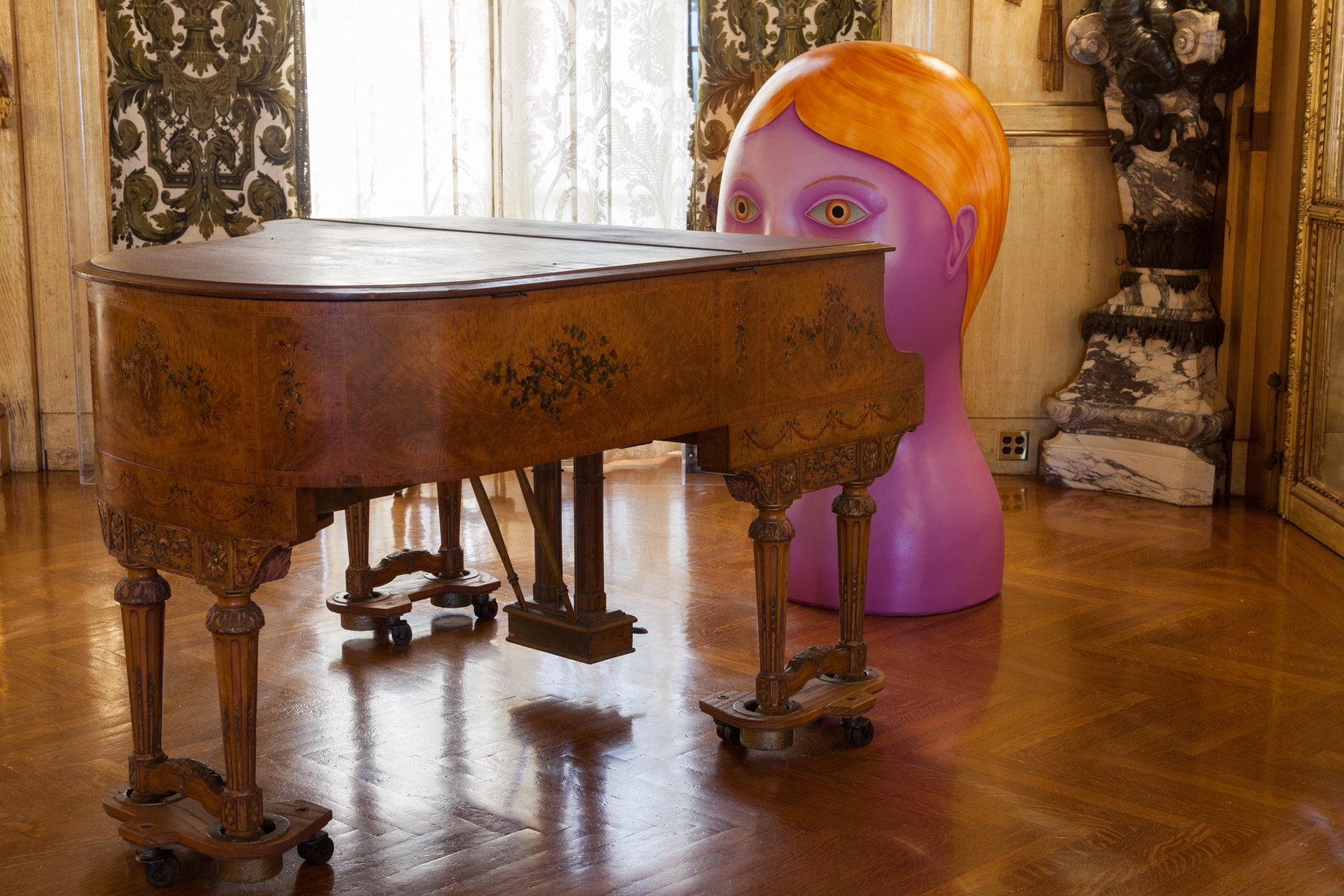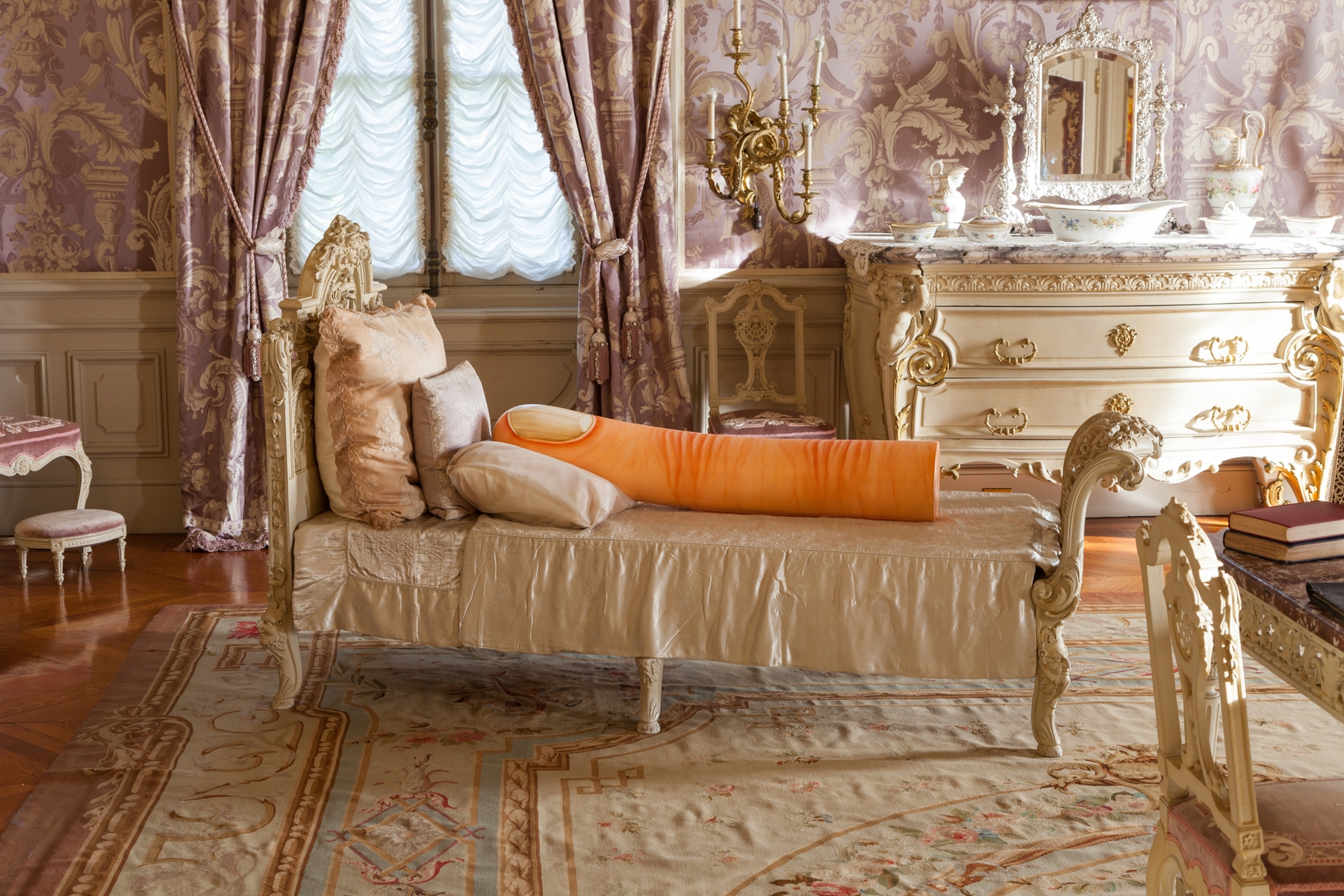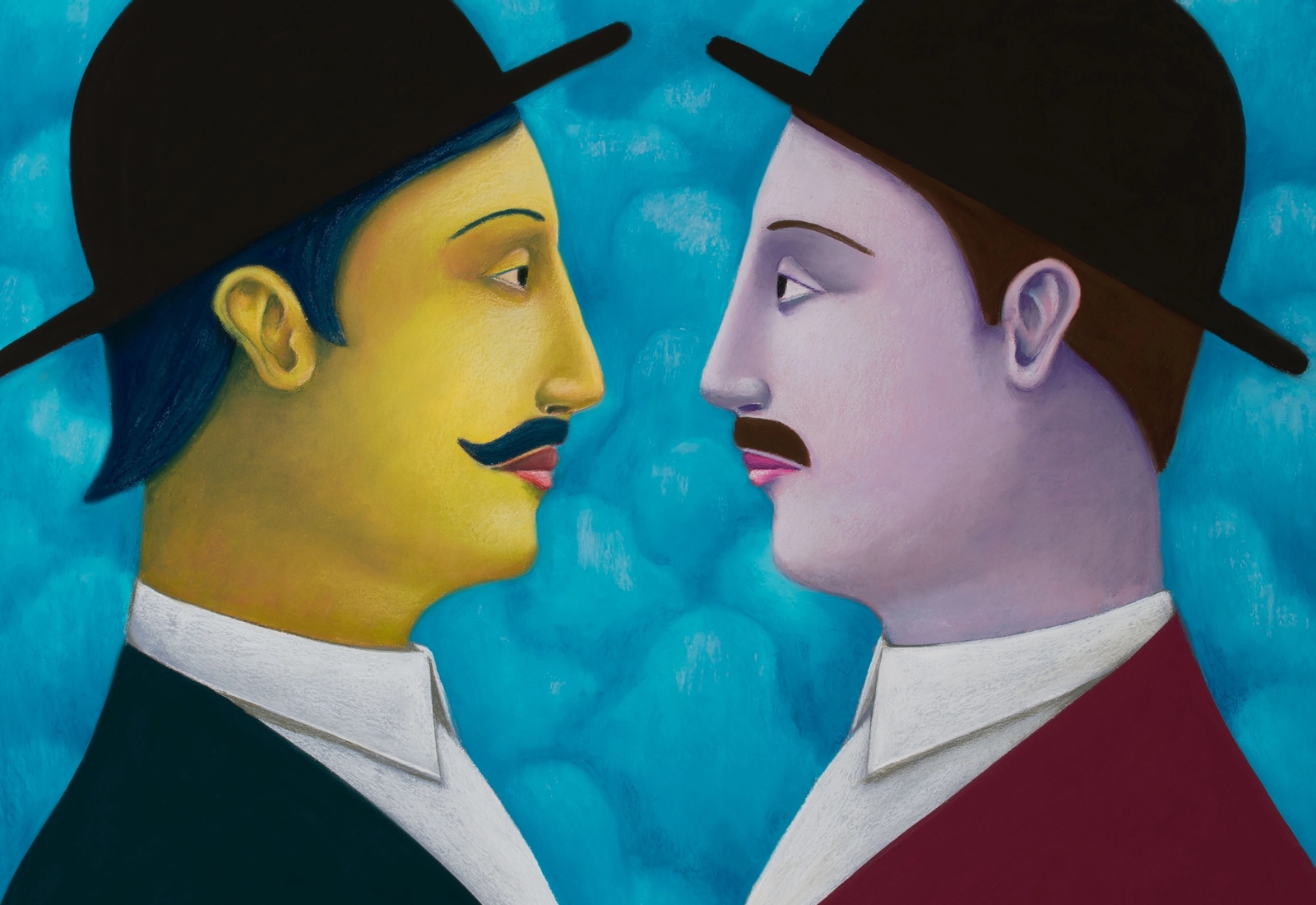The Sweet Potato and The Jar, Alex Bennett in conversation with Nicolas Party
INTERVIEW Alex Bennett
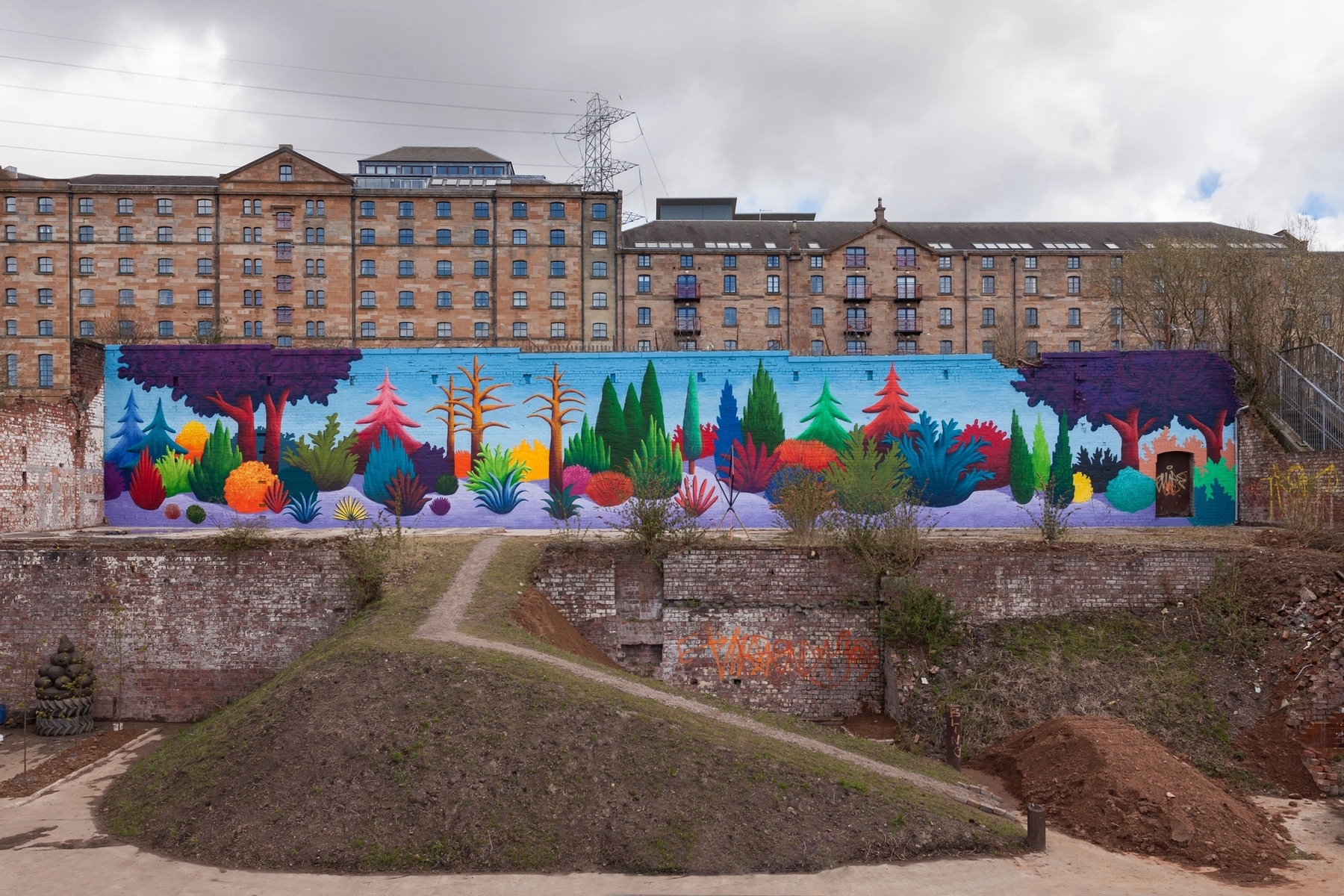
Nicolas Party deals in the machinations of desire: vibrancy and stasis. Handsome extravagance meets the flawlessly ethereal in paintings and pastels, but there’s some clowning too: pantomiming proportions, ballooning Russian dolls, trompe l’oeil fizzing with a hot Fauvist palette.
When Party paints beyond the frame, it becomes less painstaking, more physical and pressing: murals of jellyfish, Milton Avery trees (topiary-tweaked and sub-aquatic), rendered surfaces of marble, malachite and more, gesture to a different frequency of his practice. Most fitting, then, is Party’s use of pastel: intimately somatic and possibly ephemeral. Tuned into the histories of technique and the context that developed it, Party details the subtexts of material and the histories which frame it, unpicking the gendered site of pastel.
Party’s courting of painting’s past loosens into an unreal elsewhere, radiant with the afterglow of influence. Félix Vallotton is reflected in sunsets, those pools of light merging as liquid camouflage; Giorgio Morandi-style teapots embody a smoother, velvety tone. Portraits proliferate in many forms, grand dames clothed in coiling woodland snakes, lethargic pears treated as demure millinery. Despite their subterranean neutrality, occasional portraits have shown a flash of character no matter how grandiose their total repose. The field of inspiration for Party is like the voracious pull of a horizon, irreducible and perpetual. Curious is the energy of its presentation, which might be composure itself, of vacant rootedness. It might be a decadence of inertia, like a pose — just isolation from a sequence or slipstream. In short: it might just be passion.

Alex Bennett: Let’s start with your recent show at Hauser and Wirth, which you titled Sottobosco, a term that refers to undergrowth and the life that populates the forest floor. The term is ascribed to the work of Otto Marseus van Schrieck who also features in the exhibition. The exhibition is discretely ordered into different rooms — each surface treated and coloured differently. How do you see the art historical term affecting the framework and content of your exhibition?
Nicolas Party: For this exhibition, the artist Otto Marseus van Schrieck and his sottobosco painting became the center of the show. Van Schrieck was a 17th century Dutch painter that lived on the outskirts of Amsterdam in the wetland, he was known to have a menagerie of frogs, snakes and butterflies that he painted on his forest floor still life. Sottobosco is the part of the forest that gets very little light and where mushrooms, snakes and other insects’ live.

In the show, some of the paintings are deeply referenced to his work. Some paintings are using motifs directly sampled from his paintings. There is a portrait where the torso is made out of different mushrooms; all of the mushrooms are directly taken from various van Schrieck’s paintings.

The show was directly conceived around an actual painting by him. At the centre of the gallery, I built a structure to display the painting; it looked a bit like a chapel devoted to Otto Marseus van Schrieck.
Alex Bennett: The show also includes cave paintings, presented previously for Grotto at Xavier Hufkens which also presented Insects — pastel works which recall Jan van Kessel the Elder. I didn’t know this person but it’s a very interesting reference because the detailed studies of insects and botany, the way that he positions them on the surface is quite animated, it felt like he was developing more of an aesthetic rather than just documenting something. I wanted to ask a little bit about Jan van Kessel but more broadly about how you reference art history, you mentioned sampling, what’s interesting is that you choose things which are slightly romantic, overcharged, heavily symbolic. How do you deviate or differentiate from this source material? Because what you end up producing is something more restrained and composed …
Nicolas Party: This started with Vallotton where it was very direct, I took some of the nudes that he painted and reproduced them in charcoal and placed a painting over it. When I was in Glasgow during my MFA, one of the very early paintings I did there was a still life with a sweet potato in a jar set on a plate. Part of the still life was from real life, in my friend’s studio there was this big sweet potato in a glass and I thought it was interesting to paint, then I added a plate taken from a painting by William Nicholson. At that time I just read a great essay by Merlin James about this early 20th century British painter and I wanted to create a little connection within my painting with his work. Painting can easily create bridges between different periods of art history and it’s something that I really like doing. I never think of it as a crucial part of the painting but I like the idea of making a connection to something that I love and find haunting.
I use the word ‘sampling’ because I grew up with rap and electronic music and I always found it very liberating to create a new piece of music by taking pre-existing elements from other songs.
Quite similar to the idea of the collage. Recently, with the never-ending access to images it seems that every image made is the product of samples. But maybe it was always the case, what you bring as an artist in a painting, the part that didn’t exist before, is a very small percentage.
To go back to how I sampled the work of Jan Van Kessel in my show at Xavier Hufkens; I made this series of pastels that represent those body-like shapes, it’s never really clear what they are, but they remind me of close-up body parts joining and creating creases. That’s how I actually titled them, “creases”. Over those fleshy shapes, I added those insects that are crawling, in a similar way that insects are placed on fruits in still life paintings. Those insects were sampled from Jan Van Kessel insect studies.

Alex Bennett: What’s nice is that you don’t have to read the work in that way, it’s an added extra if there’s a reference you recognise. What’s interesting is that there’s this aggregate of influence or interest but in the finished article it’s so distilled that all of that seems shrouded, it’s a way of editing.
Nicolas Party: Yes I never see those references as an essential element to acknowledge the painting. They’re just open little paths that someone can choose to go through. I also use them as a marker of what I’m looking at or reading at the time that the painting is made. Then the painting is a little bit like a diary that memorised what I’m absorbing at a given time.

Alex Bennett: I was looking over older work and seeing where things repeat every now and then, looking at Three Cats at The Modern Institute (though it comes up in multiple places), for example, the idea of trompe l’oeil, marbling and creating theses illusion of malachite and precious stone surfaces. Are these performative surfaces physically painted?
Nicolas Party: They’re all painted. The trompe l’oeil started while I was living in Brussels. Sarah Margnetti, an artist from Switzerland came to study at Van der Kelen school in Brussels, it’s a school that teaches how to paint trompe l’oeil marble and wood. I asked her if she wanted to paint trompe l’oeil texture for a show in Switzerland in 2016, it was a great experience to work with her and since then she has been part of many projects. For last show that I did Sottobosco at Hauser and Wirth in Los Angeles, she painted a chapel-like structure where we hanged the Otto Marseus van Schrieck painting. Everything from the ceiling to the floor, inside and outside was fully painted in various marble and wood surfaces.


In a way, trompe l’oeil synthetizes the whole idea of painting: a surface is painted to look like something else. In marble and wood, the idea of trompe l’oeil is almost comical; you paint over a wooden board so that wooden board looks like another type of wood.
Trompe l’oeil has a great long history; I particularly like the use of those effects in Renaissance fresco. Some of the marbles look like beautiful abstract paintings dropped in the middle of the composition. Because painting faux marble is never a pure reproduction of a preexisting, real marble you have to create your own design, it will look exactly if you look at a piece of marble that was created millions of years ago, but all the marks on it have been decided by the artist.


Alex Bennett: You’re right, painting it in that way adds another layer of captivation that the real material might not have, or the real material does something else. The technique speaks more to our imagination than the physical reality of it. From these textures it’s interesting that a lot of your work also uses pastels, you seem very engaged with technique and specific material pigments. It feels like when you address surfaces that the technique of depiction itself seems to be a real subject for you. Does that seem fair?
Nicolas Party: Absolutely, every technique embodies its own history, themes, cultural attachments, and ideologies. Since using soft pastel as my main medium, it’s been a journey toward understanding the history of the medium itself. I just did a show at the FLAG Art Foundation that explores different aspect of that medium. By retracing the historical, artistic and social context of soft pastel you understand why and how many artists used it. It’s really when I started to use this medium that I started to become attached to learning the history of a technique. We often don’t think to much about the cultural connotations of using pencil or oil within work — they all have an agenda and history.

Alex Bennett: Totally, pastel has much more coded connotations as a material, to a similar degree as steel for instance. It’s softness, romance, and baroque. Can you tell me more about the examples featured in the exhibition and how you framed it?
Nicolas Party: The show is built around the figure of Rosalba Carriera who made that medium very popular in the early 18th century. She also had a technical impact on that medium by asking fabricators to make great progress with the manufacturing of those little coloured sticks. She had a great influence on the French rococo portrait scene. Rosalba Carriera, being a very successful woman artist at her time, popularized the medium to other women in abundant number during the 18th century. With the popularly of pastel among women, it quickly became perceived as a lower medium, especially compared to oil painting. Still, to this day soft pastel is associated with women and often with many pre-conceptions.


Alex Bennett: This makes me think of your exhibition with Renee Magritte. When I look at your series’ there’s elements of Giorgio Morandi and his approach to painting objects and jugs, even to the level of attention for the brushstroke and how that would develop some kind of movement in the material. There’s Milton Avery in the trees. I’m interested in how these become bold and polished, slightly surreal, there’s often this attention to the element of shape — objects become decontextualized. In 2018 your work was paired with Renee Magritte, how did this come about? Did you produce works in reaction/relation to specific works of Magritte’s or was it a project of curation?
Nicolas Party: The SF MoMA was arranging a Magritte retrospective that year, the Magritte Museum in Brussels, who host the biggest collections of his work, landed a large group a paintings for the show in the US. It was the occasion for the Belgium institution to invite a contemporary artist to create a conversation with Magritte’s work. In a funny way I was invited to fill the gap and I took that in a literal way in some of the paintings that I made for the show. Often sampling elements of his painting into mine. For example, I painted a portrait with an owl above the head, the owl was sampled from Les compagnons de la peur where the leaves turn into owls. They included this great piece of the Vache period called The Fifth Season, where two characters viewed in profile are facing each other. I created a painting repeating that composition with two portraits, each wearing the same hats in Magritte painting. For this, I also added another Belgium reference: both portraits have a moustache, one straight moustache and one with a little curve, the same two moustaches found in Thomson and Thompson from Tintin.

Alex Bennett: Your colour palette is beautiful. Paint can have this liveliness, this physicality and be representative of the hand that gave it life. The liveness of what painting can achieve counteracts your project of representation, which is quite distant, removed, aloof. It’s interesting when looking at portraiture as well, looking how colour is used to accent them in different ways. I wanted to ask about your vitalistic colour palette, how it’s used to emphasize certain things. How do you like to use colour and to what kind of effect?
Nicolas Party: I do like those strong contrasts. Colour is a difficult thing to talk about, it’s like notes and rhythms or flavour. The vocabulary of colour is also very limited; it’s difficult to put into words what is added when a few very specific colours are used together on the canvas. You only know if it’s working when you look at it, you can’t really plan colours before you try them on a surface.

When I do a show I always paint the walls in various colours, the colour choice is made in advance for practical reasons.
I never installed a show where the colour choice was right from the first instance. You really have to experience it to know if it works.
I’m also trying to constantly learn from great masters of colour, some many great colour melodies in the work of Georgia O’Keeffe, Milton Avery, Kerry James Marshall, Nicole Eisenman and many others that I always look for inspiration.

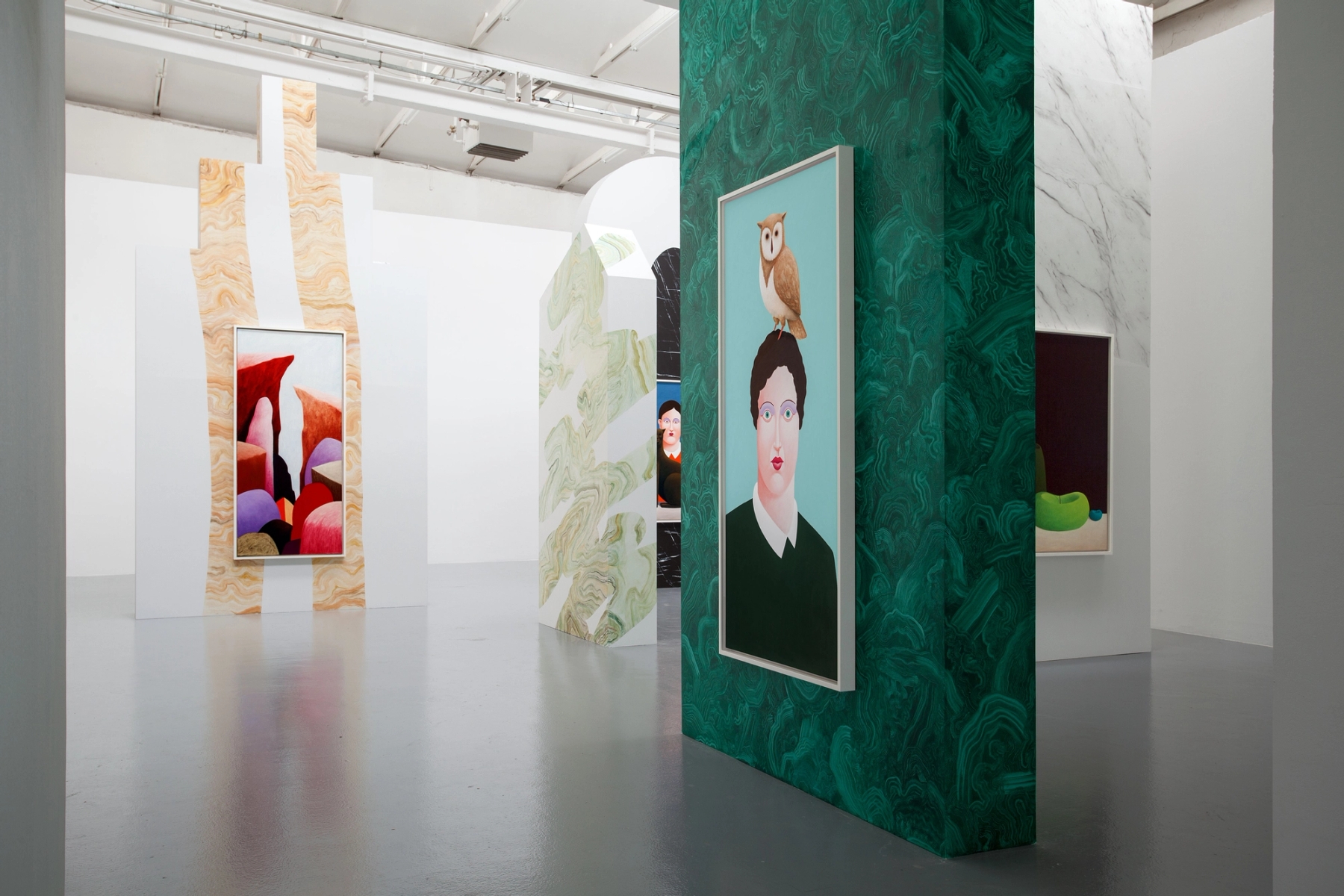
Alex Bennett: I wanted to talk to you about your murals and how they coalesce with some of your dining scenarios. You seem to be playing with the ability of painting to animate surfaces or animate a room, there’s something hushed and stately in some of your installations but there’s this other side, which is more humorous and playful. The partial solitude of your canvas meets participatory scale in ‘still life’ dinners such as Dinner for 24 Elephants (2011), Dinner for 24 Dogs (2012), or the conversational set-up with Jesse Wine in Snails in Notting Hill (2015) at RISE projects.

There’s painting with a much more social dimension. Can you tell me about that transition from something discrete on the canvas to atmosphere building and stage-settings and what motivates that interest?
Nicolas Party: When I was a teenager, I was doing a lot of graffiti. The performative aspect was often more important than the result that will disappear the next day. Painting a train by night is mostly about the action, working as a team, scouting, running out, it’s all very thrilling. It’s also a time-based act, you only have 20 minutes to do your graffiti, that makes all the preparation very important. After art school I was looking for a similar type of experience that I lost when I stopped doing graffiti. It took many forms of collaborative projects often involving a performance aspect. I created quite a few set stages for musical events that we organised with two other artists over a couple of years, for example. This idea of doing a set for different events was always something that I was happy to be involved with. When I did my first show at The Modern Institute in Glasgow, the idea of doing a set for an artist dinner took form.
The artist dinner seems like a performance itself with different characters playing specific roles, the artist, the gallerist, the collector, the curator. By creating a set for the event it emphasised the theatricality of the occasion.

My last question is about this exhibition at Marble House. I’m interested in your sculpture where the works occupy rooms in the house — fingers on beds, busts in living rooms, and portraits on desks. There’s obviously a lot of humour in that, there were obvious obstructions in the space but at other points they were trying to be more camouflaged in the environment. Can you tell me more about your approach to sculpture in general but also in reference to that exhibition?
I did my first sculpture show in Zurich at Gregor Staiger in 2018. It was the first time that I only showed 3D objects, the sculptures on show were a series of painted heads. Each head was the same shape but all different sizes; the smallest one was 10cm in height and the largest one, 100cm. The shape of the sculpture was a simplified form of a head, without any details, those missing elements in the object itself: ears, eyes, lips were painted on it. In the show, the heads were places on different sized plinths, all painted in trompe l’oeil marble and wood.

Since that show I started to explore the theme of the polychrome, the history of the painted sculpture. It’s a well-known fact now but it’s still fascinating to remember that we thought for so long that the Greek and Roman sculptures were not painted. The cult of the white marble sculpture representing mainly bodies implies so many problematic aspect of our western culture.
Whiteness in the history of western art is still so problematic that people have a hard time to approach it fully. It seems reasonable to argue that we deliberately decided to ignore the polychromies of antique sculptures in order to push the concept of the white body as the standard aesthetic par excellence.
It’s interesting to remember that the whole idea of painting a sculpture became so unpopular after the Renaissance. This thin layer of colour over a piece or marble was a sacrilege to the purity of the stone and what it represented; any tones other than purest white marble were not seen as beautiful.

I started exploring the idea of polychrome sculpture with the heads and then I started to explore the process with different body parts, fingers, feet, the torso. Having those different objects gave me all sorts of new options to use space. For the show at the Marble House in Newport, I displayed those different body parts inside a preserved domestic environment, turned into a museum. In the same way that Versailles works as a museum, you visit the house displayed when it was inhabited. The marble is a sort of absurd collage of European style put inside a late 19th century American house. The library room is medieval, the dining room baroque, a rococo bedroom ... It was of course very fun to display my differing sculptures in such a particular environment.
